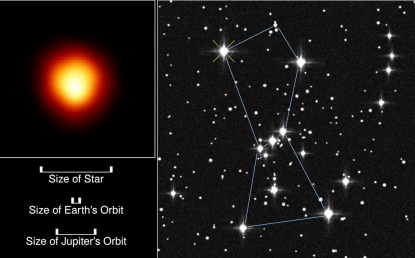Khi Cygni
Khi Cygni: Overshadowing the Bride
By Dr. Kristine Larsen, Central Connecticut State University
By Dr. Kristine Larsen, Central Connecticut State University
 The pulsating red supergiant Antares (“anti-Mars”), at V = 1.06, is the 15th-brightest star in the night sky, but it gets less attention than its near-twin Betelgeuse. Check the length of their entries in wikipedia, for instance.
The pulsating red supergiant Antares (“anti-Mars”), at V = 1.06, is the 15th-brightest star in the night sky, but it gets less attention than its near-twin Betelgeuse. Check the length of their entries in wikipedia, for instance.
On April 2, 2006 H. Nishimura of Japan discovered a 10.5 magnitude nova based on two photographs taken with his Pentax camera. Similar photos (limiting magnitude 12) showed no object as recently as March 28 of that year, and CCD measurements taken soon after found the object had brightened to 8.5 on April 4/5 (Green 2006). The maximum occurred shortly thereafter, reaching magnitude 8.1. Pre-maximum spectra were obtained, and initial data suggested that this object was a fast Fe-II iron-type nova.
Just over one year ago, a small spacecraft called MOST began a month-long observing run on one of the most spectacular objects in Earth's skies, the beautiful Trapezium region at the heart of the Orion Nebula, M42. My collaborators and I applied for and received this observing time to survey variability in this young stellar cluster -- partly to study the eclipsing binary BM Ori (theta 01 Orionis B), but also to survey as many young stars that we were able to using the unique capabilities of MOST. Since then, I along with my collaborators -- our Director Arne H
Mira variables are the longest-observed class of stars for which we have long-term quantitative data that allow us to study their behavior over centuries-long periods of time. Fortunately for us, they're also easy to observe and monitor, having some of the largest amplitudes of all variables, and hundreds of them are bright enough that they're within reach of astronomers with modest telescopes.